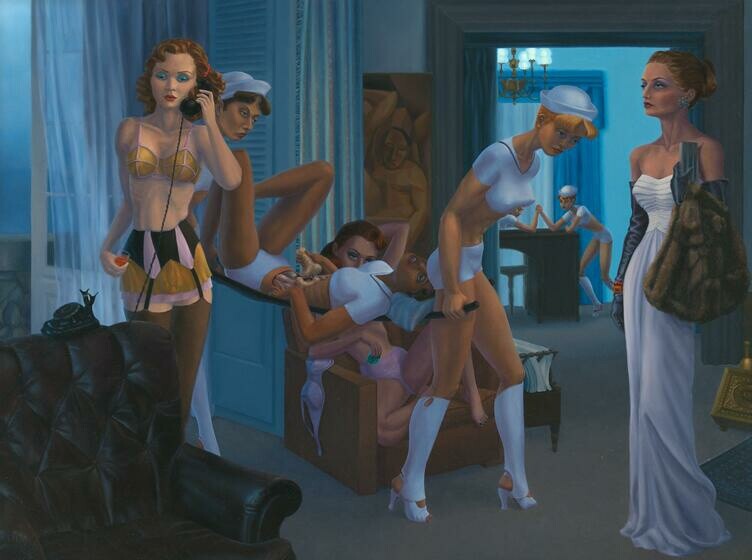Hilary Harkness’s Drunk Girl Observing A Flower is being offered in Sotheby’s Contemporary Art auction through 18 March.
T
he back is like a postcard. There are two bright, circular stickers in a top corner, and scrawled notes from the artist in permanent marker. The annotations offer small but key details about the tableau on the other side: it is an oil painting on a wood panel by Hilary Harkness, it was made in 1999 and entitled Drunk Girl Observing A Flower. It was painted at the artist’s then-apartment in San Francisco: 1280 Grove Street. The view, Harkness adds in a bracketed aside, was observed “from my window.”
On the reverse, Harkness offers something more complicated: a brothel scene that is dark and joyful and carnal, impossibly intricate. It’s rendered as a bird’s-eye smattering of many tiny, supercharged worlds, all contained within one whole – a moonlit alternate landscape in which external boundaries have dissolved, leaving everything inside and outside at once, every action both hidden and performed. The frame is dominated by two multi-storey structures, split open like dollhouse cross-sections. They riff off a certain breed of Berkeley architecture: roofs of terracotta tiles, masses of teal, feature walls inset with showy, jet black river stones, gaping archways.

The slender, cartoonish figures of more than three dozen anonymous women fill every possible space. They stand doe-eyed on balconies, like TV Bachelorettes. They lounge with shishas on piles of cushions, smoke curling around them, or walk prettily across the dark grass, tiny bags dangling at their wrists. The majority of these figures are engaged in brazen, violent acts: clutching clubs and bloodied knives, grabbing elbows and arms, or shouting from megaphones as other women crawl before them on all fours. A few teenage-looking bodies lie curled on the floor, hands over their ears. Nearly all the women are blonde (elegant up-dos and 90s crops), and in dresses and heels. There are no men present, only farm pigs, some of which are being walked like pets, others who are captured falling mid-air, their insides ripped straight out.

What was actually outside Harkness’s San Francisco window at the time was an auto-body shop. But she was surrounded by sex and the complexities of queerness, she was understanding her body in relationship to others, and (just maybe?) desirous of being blonde. She had moved to the city after getting her MFA at Yale, and quickly entered a period of ripe experimentation, the kind that emerges only when you feel you’ve got nothing to lose. “I decided to give painting my all for a few years, when no one was looking,” she explains, over Zoom, from her Brooklyn apartment and studio. “At the time, San Francisco was all about Ellen Gallagher and Barry McGee and the “Beautiful Losers.” But I didn’t know any of that. I was just on my own planet, painting.”
“Unless I’m in the right state of mind, painting can be a drag, and so I put in all this sex and stuff and people I know, because I want to be happy on a daily basis.”

D runk Girl Observing A Flower contains themes the artist is still interrogating over two decades later: pleasure and power, sex and perversity, queerness, tenderness, domesticity, contained viewpoints, revisionist histories, and what The New York Times once dubbed “lesbian utopias.” Since its completion, her painting Shore Leave, made the very next year, was acquired by the Whitney. It features erect-nippled sailors outfitted in hot pants and heels carrying a wounded comrade into a tired brothel waiting room. (She explains it was, like Drunk Girl, partly informed by the Chinese poet Li Bai, whose writing “sympathized with ordinary people and seemed to have a great apathy for senseless wars.”) Harkness has had seven solo shows and dozens of group exhibitions, and been represented by two New York spaces: the now-shuttered Mary Boone Gallery, and currently by P.P.O.W. “I remember, with these earlier paintings, thinking, ‘I’m never going to sell these for more than a couple of hundred dollars,’” she says. “I knew I had to make them incredible, so that they wouldn’t be thrown out. They are very much made for domestic environments, containing a microcosm of a world, and able to exist outside any series.”

Harkness’s wildly imaginative, narrative-led paintings have become increasingly realistic. Personas are individualized, modeled by people she casts very particularly for each role—including her wife, Ara Tucker. The more complex compositions have a Where’s Wally quality, crammed with wry art-world references (think Lee Krasner touching up a Jackson Pollock during his drunkest years, or gallerist Matthew Marks cheekily pilfering some works), historical personas (there’s a series on Gertrude Stein and Alice B Toklas), orgiastic scenes (see the wartime frenzy of Red Sky in The Morning ), interracial love (she is also in an interracial marriage), sex that’s thrilling or banal and pushed into the marginalia, and props she buys or borrows (think a doily and ashtray belonging to her great grandparents, hiding on one panel in plain sight). “Unless I’m in the right state of mind, painting can be a drag,” she explains. “And so I put in all this sex and stuff and people I know, because I want to be happy on a daily basis.”

As utterly singular as it is, Harkness’s practice does not exist in a vacuum, and her references are careful. Her cross-sections – which are entirely hand-drafted and “can easily take over a year” – recall early perspective paintings of the Sienese Renaissance, especially those by Il Sassetta, who had a masterful handle on spatial relationships. In both artists’ work, structural, multi-dimensional architecture is used as a framing agent, facilitating an interplay of gestures that guide the viewer’s eye around the scene, toward multiple points of tension, boredom and bliss, all clamoring for attention with fire-alarm urgency. “I would like to create a tableau,” Harkness smiles, “where people are seduced into suspending disbelief for that moment of looking.”

